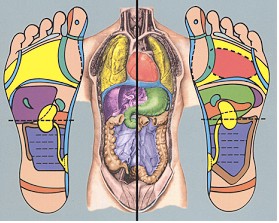Reflexology
What is Reflexology?
The story of Reflexology begins early in human history, in China, where reflexology and acupuncture were developed concurrently, some 6,000 years ago. Murals of ancient medical practices, including foot and hand reflexology and other medical practices, were discovered in the Egyptian tomb of Ankhemor dating back some 4,000 years.
In Reflexology, the feet and the hands and ears represent the entire body and all glands, organs and systems are reflected in miniature. The art of Reflexology is the application of appropriate pressure to specific points and areas on the feet and hands. Different reflex points correspond to specific areas in the body and the practitioner, by using an applied pressure on these reflexes, will trigger a beneficial effect on the entire organism, thus influencing a person’s general health. Reflexology induces relaxation, allowing the body to begin to heal itself. It reduces stress (held responsible for 85−90% of disease in the body), and also increases nerve supply and blood and lymphatic circulation. And over time, used regularly, Reflexology will allow the body to tune, tone and retrieve its own balance.
How does it work?
To demonstrate how Reflexology works, let’s locate the kidney reflex (as shown in the yellow kidney reflex below) in the arch in the center of the plantar surface of the foot. When a Reflexology practitioner uses thumbs or fingers to apply appropriate pressure to this area, it affects kidney functioning. This is true for any of the reflex points on the foot and their corresponding area of the body.
Although Reflexology is not used to diagnose or cure disease, millions of people around the world use it to attain lower stress levels, pain reduction, and more efficient and better functioning physically, emotionally and mentally. Reflexology may be used on its own or as a complement to other treatments when addressing many conditions, such as anxiety, allergies, asthma, carpal tunnel syndrome, cancer treatment, cardiovascular issues, chronic pain, diabetes, headache, kidney function, PMS, sinusitis, and sciatic pain, to name just a few. The exact mechanism the body uses to communicate between the reflexes and the different body parts has yet to be identified. Certain people feel in their bodies the corresponding points being touched on the foot.



